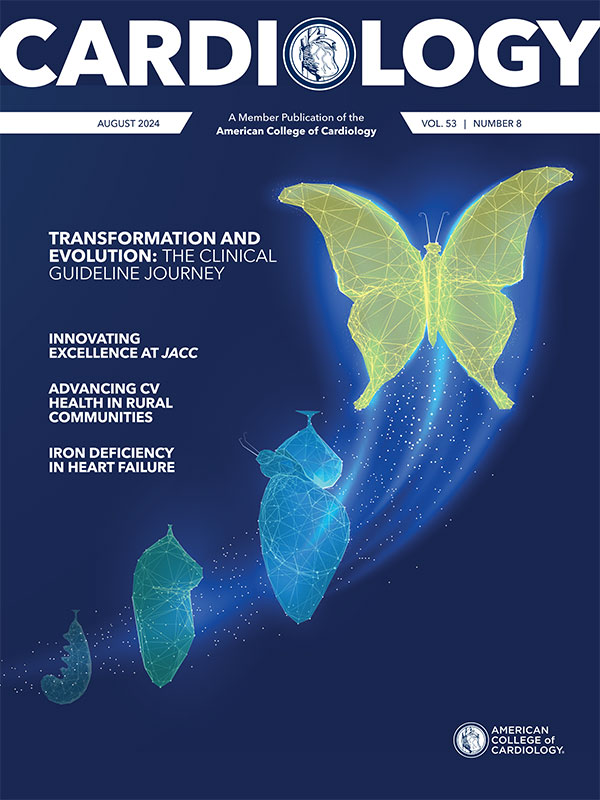Focus on Heart Failure | Ironclad: The Treatment of Iron Deficiency in Heart Failure

Iron deficiency (ID) is a common comorbidity among patients with heart failure (HF), and it is associated with reduced exercise tolerance and quality of life and serves as a marker of increased risk of hospitalizations and mortality.1-5 To improve functional status among patients with HF, research began to explore ID as a potential clinical target over 20 years ago.6-11
Since then, a breadth of randomized clinical trials and meta-analyses have emerged, focused on the association of ID treatment and clinical outcomes, including NYHA functional class, quality of life, and HF hospitalizations and mortality, yet knowledge gaps remain.
Prevalence
ID has been reported in more than 50% of patients with chronic HF, irrespective of left ventricular ejection fraction (LVEF), and this number is even higher among patients with acute HF.4-12 Moreover, as NYHA functional class declines, the prevalence of ID increases.13-15 Despite this common comorbidity, ID remains underrecognized and undertreated among patients with HF.16,17
Definition and Guidelines
A Clinical Case
Ms. A is a 66-year-old woman with a history of nonischemic dilated cardiomyopathy and NYHA functional class II symptoms who is admitted for acute decompensated HF for the second time this year.
Physical examination is notable for elevated jugular venous distension, an S3 gallop and warm lower extremities with bilateral pitting edema to the mid-shins. Electrocardiogram shows normal sinus rhythm, a narrow QRS complex and no ischemic changes.
Laboratory studies on admission are significant for a hemoglobin of 11 g/dL, ferritin concentration of 120 μg/l, TSAT of 15%, and NT-proBNP of 5,000 pg/ml. She has negative serial troponins and normal end organ function. Her transthoracic echocardiogram shows an LVEF of 40%.
She is started on IV furosemide and maintained on her home guideline-directed medical therapy, including dapagliflozin, sacubitril-valsartan, metoprolol and spironolactone.
Following three days of IV diuresis, her volume status has improved significantly, she is transitioned to oral furosemide, and nearing discharge. She asks if there are any additional treatments to improve her symptoms and lower her risk for readmission for HF.
Ms. A received 750 mg of IV ferric carboxymaltose with plans for her second dose seven days after hospital discharge. At 12 weeks post discharge, she has improved functional status and has remained out of the hospital.
Knowledge gaps remain in how to best define ID in patients with HF, as well as which populations of patients with HF will ultimately benefit from iron supplementation. Chronic HF is associated with increased systemic inflammation, which is known to play a role in the regulation of iron stores in the body.18
The traditional markers to diagnose ID and anemia are further influenced by demographic factors (age, sex, ethnicity), common comorbidities among patients with HF (diabetes, chronic kidney disease) and frequently used medications including beta-blockers and SGLT2 inhibitors.19
The ESC and ACC/AHA/HFSA guidelines define ID as a ferritin concentration of <100 μg/l, or 100-300 μg/l plus a transferrin saturation (TSAT) <20%.20, 21 Notably, impaired hemoglobin synthesis resulting in anemia only occurs in one-third of patients with ID, thus the definition does not incorporate hemoglobin or serum iron in the diagnosis to capture more patients with true ID.12,22
Current guidelines recommend a baseline anemia assessment for all patients with HF, including serum hemoglobin, ferritin and TSAT levels. The ESC guideline expands further and recommends determining iron status before discharge for patients admitted with decompensated HF and to conduct periodic assessments as an outpatient. Treatment is recommended for symptomatic patients with LVEF <45% based on a level of evidence 2a.21
Oral Iron
Oral iron supplementation is not considered sufficient in the management of ID for HF patients. Oral iron preparations have been associated with high rates of side effects and poor absorption; moreover, the proinflammatory state in many HF patients interferes with appropriate iron absorption and availability.19,23,24 Trial data using various oral formulations have demonstrated inconsistent and minimal changes to clinical outcomes.12,25-27
The IRONOUT HF trial was a double-blinded, randomized, placebo-controlled trial enrolling 225 patients with LVEF <40%, ferritin levels between 101-229 μg/l and TSAT <20%.28,29 Patients were randomized to receive oral iron twice daily for 16 weeks vs. placebo; the primary endpoint was a change in peak oxygen uptake from baseline to 16 weeks. No significant difference was seen at the end of the study period between the two groups; moreover, there was no change in secondary endpoints including change in natriuretic peptide levels or six-minute walk test (6MWT).
IRON-HF is the only trial to compare intravenous (IV) and oral iron supplementation in patients with HF, however it was underpowered due to low recruitment.30,31 This small trial enrolled patients with LVEF <40% and NYHA functional class II-IV.
Additional inclusion criteria were hemoglobin between 9-12 g/dl, TSAT <20% and ferritin <500 μg/l. Patients were randomized to receive oral iron therapy, IV therapy or placebo. The IV iron group was the only treatment arm with a significant increase in peak oxygen consumption after three months of follow-up.
IV Iron
Clinical trials incorporating IV iron formulations most commonly include iron sucrose or ferric carboxymaltose. The administration of IV iron allows for higher amounts of Fe3+ delivered directly into the bloodstream in one dose.12,32
Data to assess the effectiveness of IV iron on clinical outcomes in patients with HF have provided overall promising results, although not consistently reproducible. Discrepancies have been attributed to differences in inclusion criteria of HF patients, variations in the definition of ID, and the IV formulation used.19

The FAIR-HF trial was one of the earliest large-scale studies to influence guidelines for the management of patients with HF.1 This was a double-blind, placebo-controlled multicenter trial enrolling 459 patients with reduced LVEF and NYHA class II or III with ID defined by the criteria described above.
Patients were randomized to receive IV ferric carboxymaltose or placebo in two phases: the first was a correction phase with weekly doses of 200 mg based on their calculated iron deficit, and the second a maintenance phase of a monthly dose of 200 mg.
The primary endpoint was a self-reported patient global assessment at 24 weeks. The results demonstrated improved assessments in 50% of patients in the treatment arm vs. 28% in the placebo arm (odds ratio, 2.51; 95% CI, 1.75-3.61), regardless of the presence of anemia. Secondary outcomes including 6MWT and Kansas City Cardiomyopathy Questionnaire also showed a statistically significant benefit in the treatment arm compared to placebo.
The CONFIRM-HF trial published in 2014 also demonstrated similar results with improvements in 6MWT at both 24 weeks and 52 weeks for patients treated with IV iron compared to the placebo group.33 The EFFECT HF trial, although nonblinded, showed improvements in peak oxygen consumption among NYHA functional class II patients randomized to ferric carboxymaltose compared to standard of care.34
Both the AFFIRM-AHF and IRONMAN trials enrolled symptomatic patients with HF, reduced LVEF and ID to evaluate the effect of IV iron on the primary outcome of hospital readmission for HF or cardiovascular death.35,36
The AFFIRM-AHF trial enrolled all patients during a hospitalization and used ferric carboxymaltose, and IRONMAN enrolled some patients during a hospitalization and used ferric derisomaltose.
Click here for ACC's free online course on ID in HF.
Neither trial showed a statistically significant difference in the primary outcome; however, a prespecified sensitivity analysis showed a reduced risk of readmission for HF among patients treated with IV iron. Enrollment and follow-up of both trials were impacted by the coronavirus pandemic.37
Graham, et al., published an updated meta-analysis for IV iron in patients with HF and ID following the publication of the AFFIRM-AHF and IRONMAN trials. The analysis included 10 randomized controlled trials of more than 3,000 patients with HF with at least mildly reduced LVEF and ID comparing IV iron with standard of care or placebo.38
The primary outcome was the composite of recurrent HF hospitalization and cardiovascular mortality restricted to one year of follow-up or less. The most common definition of ID was serum ferritin <100 μg/L or TSAT <20% plus ferritin 100-300 μg/L; most trials excluded patients with hemoglobin <9 or >4-15 g/dl.
Results demonstrated that IV iron of various formulations reduced the primary outcome by 25%, primarily driven by a reduction in HF hospitalizations (rate ratio, 0.75; 95% CI, 0.61-0.93). Subgroup analysis suggested trends towards a more substantial benefit for patients with ischemic heart disease or patients with a TSAT <20%.
The HEART-FID trial was the most recently published double-blind, randomized, controlled trial, with 3,065 symptomatic patients with LVEF ≤45%, ID and either a HF hospitalization within the past year or an elevated natriuretic peptide level. Patients were randomized to receive ferric carboxymaltose or placebo.
The results showed no significant difference in the hierarchical composite endpoint of death, hospitalization for HF or change in 6MWT utilizing a stricter significance level of p=0.01.39 The population enrolled was lower risk and had a higher baseline TSAT (mean 23.9%), thus including a patient population that may not receive the most benefit from IV iron supplementation.37 HEART-FID and other studies suggest that a benefit may be more closely associated with a TSAT level <20%.38
IV Iron and HFpEF
Most clinical trial data to date has focused on the effectiveness of IV iron therapy for patients with HF and at least mildly reduced LVEF. Data for patients with HF and preserved EF (HFpEF) are limited to single center retrospective studies.40
Two randomized controlled trials are ongoing to help answer this question. The FAIR-HFpEF study (NCT03074591) aims to assess the effect of IV iron of exercise tolerance for patients with LVEF >45% and ID, and the PREFER-HF (NCT03480633) aims to evaluate the effect of both oral and IV iron on symptoms and functional class.41
Conclusion
Patients with symptomatic HF and ID have reduced quality of life and increased morbidity and mortality. In addition to guideline-directed medical therapy, IV iron has the potential to improve symptoms and reduce the risk of HF hospitalizations in carefully selected patients.

This article was authored by Elena M. Donald, MD, a fellow-in-training in Adult Cardiovascular Disease at Columbia University Irving Medical Center-New York Presbyterian Hospital.
References
- Anker SD, Comin Colet J, et al. Ferric carboxymaltose in patients with heart failure and iron deficiency. N Engl J Med 2009;361:2436-48.
- Jankowska EA, von Haehling S, Anker SD, et al. Iron deficiency and heart failure: diagnostic dilemmas and therapeutic perspectives. Eur Heart J 2013;34:816-29.
- Enjuanes C, Klip IT, Bruguera J, et al. Iron deficiency and health-related quality of life in chronic heart failure: results from a multicenter European study. Int J Cardiol 2014;174:268-75.
- Klip IT, Comin-Colet J, Voors AA, et al. Iron deficiency in chronic heart failure: an international pooled analysis. Am Heart J 2013;165:575-582 e3.
- Jankowska EA, Rozentryt P, Witkowska A, et al. Iron deficiency: an ominous sign in patients with systolic chronic heart failure. Eur Heart J 2010;31:1872-80.
- Silverberg DS, Wexler D, Blum M, et al. The use of subcutaneous erythropoietin and intravenous iron for the treatment of the anemia of severe, resistant congestive heart failure improves cardiac and renal function and functional cardiac class, and markedly reduces hospitalizations. J Am Coll Cardiol 2000;35:1737-44.
- Bolger AP, Bartlett FR, Penston HS, et al. Intravenous iron alone for the treatment of anemia in patients with chronic heart failure. J Am Coll Cardiol 2006;48:1225-7.
- Swedberg K, McMurray JJ, Young JB. Darbepoetin alfa in systolic heart failure. N Engl J Med 2013;369:488-9.
- Swedberg K, Young JB, Anand IS, et al. Treatment of anemia with darbepoetin alfa in systolic heart failure. N Engl J Med 2013;368:1210-9.
- Toblli JE, Lombrana A, Duarte P, Di Gennaro F. Intravenous iron reduces NT-pro-brain natriuretic peptide in anemic patients with chronic heart failure and renal insufficiency. J Am Coll Cardiol 2007;50:1657-65.
- Cohen-Solal A, Leclercq C, Deray G, et al. Iron deficiency: an emerging therapeutic target in heart failure. Heart 2014;100:1414-20.
- von Haehling S, Ebner N, Evertz R, et al. Iron deficiency in heart failure: an overview. JACC Heart Fail 2019;7:36-46.
- Okonko DO, Mandal AK, Missouris CG, Poole-Wilson PA. Disordered iron homeostasis in chronic heart failure: prevalence, predictors, and relation to anemia, exercise capacity, and survival. J Am Coll Cardiol 2011;58:1241-51.
- Alcaide-Aldeano A, Garay A, Alcoberro L ,et al. Iron deficiency: impact on functional capacity and quality of life in heart failure with preserved ejection fraction. J Clin Med 2020;9.
- Sindone A, Doehner W, Comin-Colet J. Systematic review and meta-analysis of intravenous iron-carbohydrate complexes in HFrEF patients with iron deficiency. ESC Heart Fail 2023;10:44-56.
- Cohen-Solal A, Damy T, Terbah M, et al. High prevalence of iron deficiency in patients with acute decompensated heart failure. Eur J Heart Fail 2014;16:984-91.
- Wahid M, Islam S, Sepehrvand N, et al. Iron deficiency, anemia, and iron supplementation in patients with heart failure: a population-level study. Circ Heart Fail 2024;17:e011351.
- Crielaard BJ, Lammers T, Rivella S. Targeting iron metabolism in drug discovery and delivery. Nat Rev Drug Discov 2017;16:400-23.
- Lakhal-Littleton S, Cleland JGF. Iron deficiency and supplementation in heart failure. Nat Rev Cardiol 2024;21:463-86.
- Ponikowski P, Voors AA, Anker SD, et al. 2016 ESC guidelines for the diagnosis and treatment of acute and chronic heart failure. Rev Esp Cardiol (Engl Ed) 2016;69:1167.
- Heidenreich PA, Bozkurt B, Aguilar D, et al. 2022 AHA/ACC/HFSA guideline for the management of heart failure: executive summary. J Am Coll Cardiol 2022;79:1757-80.
- McDonagh MS, Blazina I, Dana T, et al. Screening and routine supplementation for iron deficiency anemia: a systematic review. Pediatrics 2015;135:723-33.
- Anker SD, von Haehling S. Inflammatory mediators in chronic heart failure: an overview. Heart 2004;90:464-70.
- McDonagh T, Macdougall IC. Iron therapy for the treatment of iron deficiency in chronic heart failure: intravenous or oral? Eur J Heart Fail 2015;17:248-62.
- Zdravkovic SC, Nagorni SP, Cojbasic I, et al. Effects of 6-months of oral ferrous and ferric supplement therapy in patients who were hospitalized for decompensated chronic heart failure. J Int Med Res 2019;47:3179-89.
- Karavidas A, Troganis E, Lazaros G, et al. Oral sucrosomial iron improves exercise capacity and quality of life in heart failure with reduced ejection fraction and iron deficiency: a non-randomized, open-label, proof-of-concept study. Eur J Heart Fail 2021;23:593-7.
- Suryani LD, Raharjo SB, Sagita R, et al. Oral ferrous sulphate improves functional capacity on heart failure patients with iron deficiency anemia. Glob Heart 2022;17:81.
- Lewis GD, Malhotra R, Hernandez AF, et al. Effect of oral iron repletion on exercise capacity in patients with heart failure with reduced ejection fraction and iron deficiency: the ironout hf randomized clinical trial. JAMA 2017;317:1958-66.
- Lewis GD, Semigran MJ, Givertz MM, et al. Oral iron therapy for heart failure with reduced ejection fraction: design and rationale for oral iron repletion effects on oxygen uptake in heart failure. Circ Heart Fail 2016;9.
- Beck-da-Silva L, Piardi D, Soder S, et al. IRON-HF study: a randomized trial to assess the effects of iron in heart failure patients with anemia. Int J Cardiol 2013;168:3439-42.
- Beck-da-Silva L, Rohde LE, Pereira-Barretto AC, et al. Rationale and design of the IRON-HF study: a randomized trial to assess the effects of iron supplementation in heart failure patients with anemia. J Card Fail 2007;13:14-7.
- Danielson BG. Structure, chemistry, and pharmacokinetics of intravenous iron agents. J Am Soc Nephrol 2004;15 Suppl 2:S93-8.
- Ponikowski P, van Veldhuisen DJ, Comin-Colet J, et al. Beneficial effects of long-term intravenous iron therapy with ferric carboxymaltose in patients with symptomatic heart failure and iron deficiencydagger. Eur Heart J 2015;36:657-68.
- van Veldhuisen DJ, Ponikowski P, van der Meer P, et al. Effect of Ferric carboxymaltose on exercise capacity in patients with chronic heart failure and iron deficiency. Circulation 2017;136:1374-83.
- Kalra PR, Cleland JGF, Petrie MC, et al. Intravenous ferric derisomaltose in patients with heart failure and iron deficiency in the UK (IRONMAN): an investigator-initiated, prospective, randomised, open-label, blinded-endpoint trial. Lancet 2022;400:2199-2209.
- Ponikowski P, Kirwan BA, Anker SD, et al. Ferric carboxymaltose for iron deficiency at discharge after acute heart failure: a multicentre, double-blind, randomised, controlled trial. Lancet 2020;396:1895-1904.
- Martens P, Mullens W. Treating iron deficiency in heart failure. N Engl J Med 2023;389:1041-2.
- Graham FJ, Pellicori P, Kalra PR, et al. Intravenous iron in patients with heart failure and iron deficiency: an updated meta-analysis. Eur J Heart Fail 2023;25:528-37.
- Mentz RJ, Garg J, Rockhold FW, et al. Ferric carboxymaltose in heart failure with iron deficiency. N Engl J Med 2023;389:975-86.
- Lopez-Vilella R, Lozano-Edo S, Arenas Martin P, et al. Impact of intravenous ferric carboxymaltose on heart failure with preserved and reduced ejection fraction. ESC Heart Fail 2022;9:133-45.
- Shamsi A, Cannata A, Piper S, et al. Treatment of iron deficiency in heart failure. Curr Cardiol Rep 2023;25:649-61.
Clinical Topics: Heart Failure and Cardiomyopathies, Acute Heart Failure
Keywords: Cardiology Magazine, ACC Publications, Anemia, Iron-Deficiency, Heart Failure, Ventricular Function, Left, Stroke Volume, Anemia
